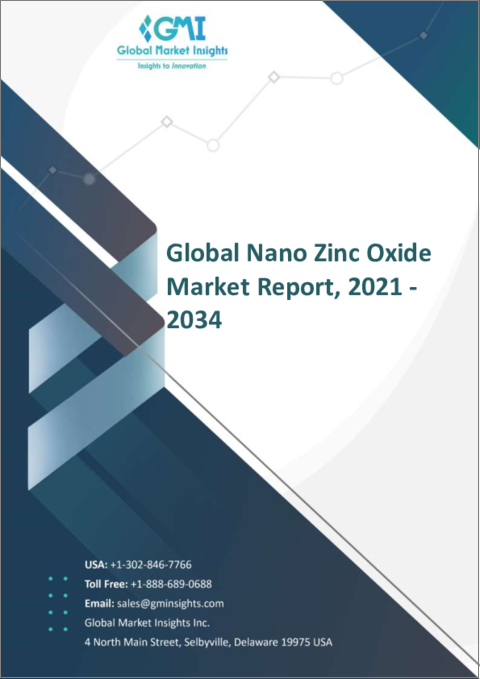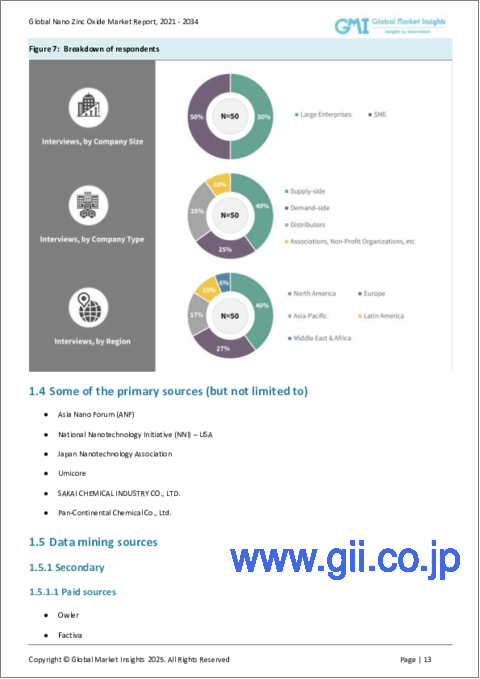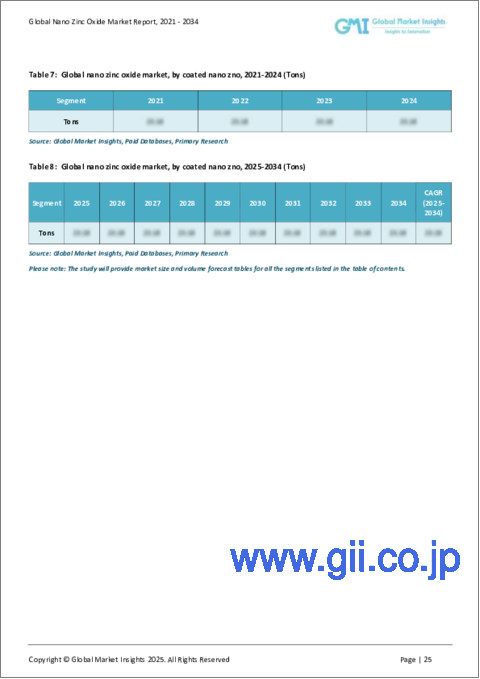|
|
市場調査レポート
商品コード
1577353
ナノ酸化亜鉛市場、機会、成長促進要因、産業動向分析と予測、2024年~2032年Nano Zinc Oxide Market, Opportunity, Growth Drivers, Industry Trend Analysis and Forecast, 2024-2032 |
||||||
カスタマイズ可能
|
|||||||
| ナノ酸化亜鉛市場、機会、成長促進要因、産業動向分析と予測、2024年~2032年 |
|
出版日: 2024年08月26日
発行: Global Market Insights Inc.
ページ情報: 英文 200 Pages
納期: 2~3営業日
|
全表示
- 概要
- 目次
ナノ酸化亜鉛の世界市場は、2023年に3億5,210万米ドルの評価額に達し、2024年から2032年までCAGR 11%で成長すると予測されています。
ナノ酸化亜鉛は、一般的に分散液や粉末の形で、通常100ナノメートル以下の直径を持つ無機ナノ粒子で構成されています。これらのナノ粒子は、抗菌性、抗真菌性、防錆性、触媒性、UVフィルタリング能力など、無数の有利な特性を誇り、多様な産業・医療分野で不可欠なものとなっています。
世界的に見ると、酸化亜鉛の生産と消費は著しいです。米国地質調査所(USGS)の報告によると、2022年の世界の亜鉛鉱山の生産量は約1,300万トンで、ナノスケールを含む酸化亜鉛の生産にかなりの割合が向けられています。さらに、欧州化学品庁(ECHA)は、主に化粧品やコーティング剤におけるUVカットと抗菌効果により、欧州連合内でナノ酸化亜鉛の採用が急増していることを強調しています。
コーティングナノ酸化亜鉛セグメントは、2023年に2億4,510万米ドルの評価を達成し、2032年まで11%のCAGRが続くと予測されています。この成長軌道は、様々な分野、特にパーソナルケア分野でのコーティングナノ酸化亜鉛の需要急増によるところが大きいです。この分野でナノ酸化亜鉛が好まれるのは、製剤の安全性と安定性を確保するために、UV保護が強化され、光触媒活性が低下しているためです。さらに、肌の健康に対する意識の高まりや、透明で白くならない日焼け止めへのシフトが、コーティングされたナノ酸化亜鉛の需要を拡大しています。
パーソナルケア&化粧品分野は、2023年には1億9,950万米ドルに達する見通しで、2024年から2032年までのCAGRは12%と予測されています。この急増は、目に見える残留物なしに効果的なUV保護を提供する日焼け止めやスキンケア製品に対する消費者需要の高まりが主な要因です。ナノ酸化亜鉛の透明性と白くならない特性は極めて重要な役割を果たしています。このセグメントの成長は、製品処方の革新と、より安全で環境に優しいスキンケアを重視する天然ミネラルベースの成分への消費者のシフトによってさらに後押しされています。
アジア太平洋のナノ酸化亜鉛市場は上昇基調にあり、2023年の評価額は1億3,150万米ドル、2024年から2032年までのCAGRは11.2%と予測されています。この勢いは、特に中国、日本、韓国などの国々でスキンケアと日焼け防止に対する意識が高まり、この地域のパーソナルケアと化粧品セクターが活況を呈していることが大きな要因となっています。ナノ酸化亜鉛のUVカットや抗菌特性を活用した電子機器やコーティングにおける先端材料の需要が、市場をさらに活性化させています。強固な製造基盤と研究開発投資の増加により、アジア太平洋地域はこの多面的ナノ材料の極めて重要な市場としての地位を固めつつあります。
目次
第1章 調査手法と調査範囲
第2章 エグゼクティブサマリー
第3章 業界洞察
- エコシステム分析
- 主要メーカー
- 流通業者
- 業界全体の利益率
- 業界への影響要因
- 促進要因
- 市場の課題
- 市場機会
- 新たな機会
- 成長可能性分析
- 原材料情勢
- 製造動向
- 技術の進化
- 持続可能な製造
- グリーン・プラクティス
- 脱炭素化
- 持続可能な製造
- 原材料の持続可能性
- 価格動向(米ドル/トン)、2021~2032年
- 規制と市場への影響
- ポーター分析
- PESTEL分析
第4章 競合情勢
- 企業シェア分析
- 競合のポジショニング・マトリックス
- 戦略展望マトリックス
第5章 市場規模・予測:製品タイプ別、2021年~2032年
- 主要動向
- コーティングナノZnO
- コーティングなしナノZnO
第6章 市場規模・予測:用途別、2021年~2032年
- 主要動向
- パーソナルケアと化粧品
- 塗料・コーティング
- テキスタイル
- エレクトロニクス
- その他の用途
第7章 市場規模・予測:地域別、2021年~2032年
- 主要動向
- 北米
- 米国
- カナダ
- 欧州
- ドイツ
- 英国
- フランス
- イタリア
- スペイン
- その他欧州
- アジア太平洋
- 中国
- インド
- 日本
- 韓国
- オーストラリア
- その他アジア太平洋地域
- ラテンアメリカ
- ブラジル
- メキシコ
- アルゼンチン
- その他ラテンアメリカ
- 中東・アフリカ
- サウジアラビア
- UAE
- 南アフリカ
- その他の中東・アフリカ
第8章 企業プロファイル
- Grillo-Werke AG
- Umicore
- SAKAI CHEMICAL INDUSTRY CO., LTD.
- Pan-Continental Chemical Co., Ltd.
- Inframat Advanced Materials, LLC
- SHOWA DENKO K.K.
- Lanxess Corporation
- Nanophase Technologies Corporation
- EverZinc
- BASF SE
The Global Nano Zinc Oxide Market reached a valuation of USD 352.1 million in 2023 and is projected to grow at a CAGR of 11% from 2024 to 2032. Nano zinc oxide, typically in the form of dispersions and powders, consists of inorganic nanoparticles with diameters usually under 100 nanometers. These nanoparticles boast a myriad of advantageous properties, such as antibacterial, antifungal, anticorrosive, catalytic, and UV filtering abilities, rendering them indispensable across diverse industrial and medical sectors.
Globally, zinc oxide production and consumption are significant. For context, the U.S. Geological Survey (USGS) reported global zinc mine production at around 13 million metric tons in 2022, with a considerable fraction directed towards zinc oxide production, including its nano-scale forms. Moreover, the European Chemicals Agency (ECHA) underscores the surging adoption of nano zinc oxide within the European Union, primarily due to its UV protection and antimicrobial benefits in cosmetics and coatings.
The overall industry is divided into type, application, and region.
The coated nano ZnO segment is anticipated to achieve a valuation of USD 245.1 million in 2023, with a consistent 11% CAGR projected until 2032. This growth trajectory is largely attributed to the surging demand for coated nano zinc oxide across various sectors, especially in personal care. Its preference in this domain stems from enhanced UV protection and diminished photocatalytic activity for ensuring safety and stability in formulations. Furthermore, heightened skin health awareness and a shift towards transparent, non-whitening sunscreens amplify the coated nano ZnO demand.
The personal care & cosmetics segment is poised to reach USD 199.5 million in 2023, with an impressive 12% CAGR forecasted from 2024 to 2032. This surge is predominantly fueled by rising consumer demand for sunscreens and skincare products that deliver effective UV protection without visible residue. Nano zinc oxide's transparency and non-whitening attributes play a pivotal role. The segment's growth is further buoyed by innovations in product formulations and a consumer shift towards natural, mineral-based ingredients, emphasizing safer and eco-friendly skincare choices.
Asia Pacific nano zinc oxide market is on an upward trajectory, with a valuation of USD 131.5 million in 2023 and a projected CAGR of 11.2% from 2024 to 2032. This momentum is largely driven by the region's booming personal care and cosmetics sector, spurred by heightened skincare and sun protection awareness, notably in nations like China, Japan, and South Korea. The demand for advanced materials in electronics and coatings, leveraging nano zinc oxide's UV protection and antimicrobial traits, further fuels the market. With a robust manufacturing foundation and escalating R&D investments, the Asia Pacific is solidifying its stance as a pivotal market for this multifaceted nanomaterial.
Table of Contents
Chapter 1 Methodology and Scope
- 1.1 Market scope and definition
- 1.2 Base estimates and calculations
- 1.3 Forecast calculation
- 1.4 Data sources
- 1.4.1 Primary
- 1.4.2 Secondary
- 1.4.2.1 Paid sources
- 1.4.2.2 Public sources
Chapter 2 Executive Summary
- 2.1 Industry 360° synopsis
Chapter 3 Industry Insights
- 3.1 Industry ecosystem analysis
- 3.1.1 Key manufacturers
- 3.1.2 Distributors
- 3.1.3 Profit margins across the industry
- 3.2 Industry impact forces
- 3.2.1 Growth drivers
- 3.2.2 Market challenges
- 3.2.3 Market opportunity
- 3.2.3.1 New opportunities
- 3.2.3.2 Growth potential analysis
- 3.3 Raw material landscape
- 3.3.1 Manufacturing trends
- 3.3.2 Technology evolution
- 3.3.2.1 Sustainable manufacturing
- 3.3.2.1.1 Green practices
- 3.3.2.1.2 Decarbonization
- 3.3.2.1 Sustainable manufacturing
- 3.3.3 Sustainability in raw materials
- 3.3.4 Pricing trends (USD/Ton), 2021 - 2032
- 3.3.4.1 North America
- 3.3.4.2 Europe
- 3.3.4.3 Asia Pacific
- 3.3.4.4 Latin America
- 3.3.4.5 Middle East and Africa
- 3.4 Regulations and market impact
- 3.5 Porter's analysis
- 3.6 PESTEL analysis
Chapter 4 Competitive Landscape, 2023
- 4.1 Company market share analysis
- 4.2 Competitive positioning matrix
- 4.3 Strategic outlook matrix
Chapter 5 Market Size and Forecast, By Product Type, 2021-2032 (USD Million, Kilo Tons)
- 5.1 Key trends
- 5.2 Coated nano ZnO
- 5.3 Un-coated Nano ZnO
Chapter 6 Market Size and Forecast, By Application, 2021-2032 (USD Million, Kilo Tons)
- 6.1 Key trends
- 6.2 Personal care and cosmetics
- 6.3 Paints and coatings
- 6.4 Textiles
- 6.5 Electronics
- 6.6 Other applications
Chapter 7 Market Size and Forecast, By Region, 2021-2032 (USD Million, Kilo Tons)
- 7.1 Key trends
- 7.2 North America
- 7.2.1 U.S.
- 7.2.2 Canada
- 7.3 Europe
- 7.3.1 Germany
- 7.3.2 UK
- 7.3.3 France
- 7.3.4 Italy
- 7.3.5 Spain
- 7.3.6 Rest of Europe
- 7.4 Asia Pacific
- 7.4.1 China
- 7.4.2 India
- 7.4.3 Japan
- 7.4.4 South Korea
- 7.4.5 Australia
- 7.4.6 Rest of Asia Pacific
- 7.5 Latin America
- 7.5.1 Brazil
- 7.5.2 Mexico
- 7.5.3 Argentina
- 7.5.4 Rest of Latin America
- 7.6 MEA
- 7.6.1 Saudi Arabia
- 7.6.2 UAE
- 7.6.3 South Africa
- 7.6.4 Rest of MEA
Chapter 8 Company Profiles
- 8.1 Grillo-Werke AG
- 8.2 Umicore
- 8.3 SAKAI CHEMICAL INDUSTRY CO., LTD.
- 8.4 Pan-Continental Chemical Co., Ltd.
- 8.5 Inframat Advanced Materials, LLC
- 8.6 SHOWA DENKO K.K.
- 8.7 Lanxess Corporation
- 8.8 Nanophase Technologies Corporation
- 8.9 EverZinc
- 8.10 BASF SE






